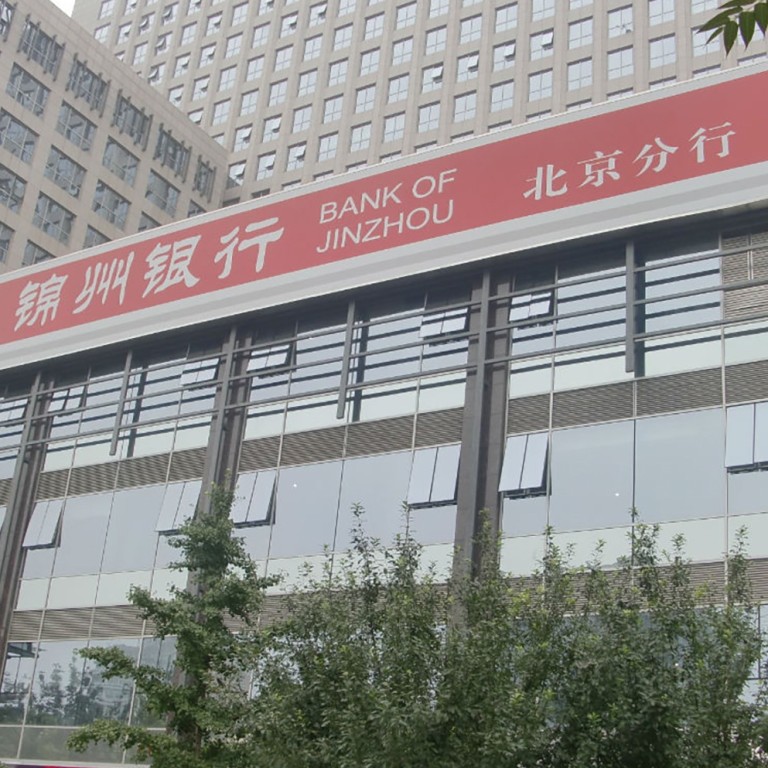
Saga of China’s Bank of Jinzhou raises questions about the health of Chinese banking sector
- China’s troubled Bank of Jinzhou is seeking to raise 6.2 billion yuan (US$866 million) just two months after it secured a 3 billion yuan (US$419 million) bailout
- Problems at the company cast a spotlight on the risks facing regional lenders in China’s banking sector
Bank of Jinzhou, a regional lender based in China’s northeast rust belt, has spent every one of the past four years fundraising, exhausting all avenues in a bid to sell an image of a fast growing bank.
The lender raised HK$6 billion (US$765 million) through an initial public offering on the Hong Kong stock exchange in 2015, sourced HK$7.5 billion (US$956 million) from a private placement in 2016, pocketed US$1.5 billion from overseas subscribers by issuing preference shares in 2017, and booked HK$8.3 billion (US$1 billion) through selling 1 billion new shares in December 2018.
The company, which said it needed the US$3.5 billion in accumulated capital to expand, hooked investors with a stellar growth story that had seen net profit rise 11 per cent in 2017, 133 per cent in 2015 and 67 per cent in 2016. But the story was too good to be true, something that came into focus early this year when the bank was late publishing its 2018 annual report and its auditor - Ernst & Young - resigned in July, citing loan inconsistencies.
But it appears the state funds are not enough for the troubled lender. The bank, which draws its name from the city of Jinzhou in Liaoning province where it is based, said on September 29 it would seek another 6.2 billion yuan (US$866 million) from domestic investors to shore up its capital base.
The authorities have sought to avoid major defaults by banks. But … we are likely to see a rising number of financial rescues
The bank’s unquenchable thirst for money has shed light on the trouble facing China’s regional lenders - and the potential cost of bailing them out. Uncovering similar problems among other small lenders and finding the resources to cover them poses a big challenge for China’s economy.
Eleanor Olcott, a China policy analyst at research firm TS Lombard, wrote in a note to clients on October 1 that the biggest challenge facing China under the leadership of President Xi Jinping was “neither the protests nor the trade war”, but cutting risk in the banking system.
Beijing is trying to assure investors that the so-called sick man banks are individual cases and the country has the means to contain any systemic risk. Yi Gang, the governor of the People’s Bank of China (PBOC), wrote in September that overall risks in China’s banking system have been curbed.
Fraser Howie, who co-authored Red Capitalism: The Fragile Financial Foundations of China’s Extraordinary Rise, said the real picture of China’s banking industry could be bleaker than what official figures suggest.
“Are the banks really doing so well? If everything is just fine why is there so much focus and work being done on debt to equity swaps, targeted required reserve ratio cuts, liquidity measures?” asked Howie, a long-term observer of China’s banking industry.
He added it would be “a long-drawn-out and painful process” for China to clean up its banking industry, although the country was unlikely to see a Lehman Brothers-style collapse.
Bank of Jinzhou’s well-crafted image of high growth and profitability was shattered when it published its long-overdue annual report for 2018 in August and an interim report for 2019 in September. It reported a loss of 4.5 billion yuan (US$629 million) in 2018 and an additional 868 million yuan (US$121 million) losses in the first six months of this year.
For investors who forked out HK$8.3 (US$1.05) a share as part of the bank’s 1 billion share offering in late 2018, two thirds of their investment has been wiped out, with the latest stock price at HK$3.12 (40 US cents). The bank also said it would cut out extra payments on preference shares bought by overseas investors.
Are the banks really doing so well? If everything is just fine why is there so much focus and work being done on debt to equity swaps, targeted required reserve ratio cuts, liquidity measures?
Bank of Jinzhou is one of 134 city commercial banks in China that account for about a sixth of the country’s total banking assets. China also has 1,427 rural commercial banks and 1,616 village and township banks.
These regional lenders have boomed over the past decade with rapidly expanding balance sheets courtesy of a state-led spending spree. But there are concerns some may struggle to weather China’s economic slowdown, according to a research note published by S&P Global Ratings in late August. Some lenders, particularly those in poor cities and rural areas, may have to merge with larger players or exit the market, the ratings agency said.
However, China’s government is pushing a different line, talking about recapitalisation rather than liquidations or mergers. Vice-Premier Liu He, who heads the Financial Stability and Development Committee, said in late September China (Central govt?) would support small banks to replenish capital and serve the local community.
But the heady days of high growth may be over for Bank of Jinzhou if it is forced to serve its local community. Jinzhou’s economy is slowing. Total gross domestic product was 119 billion yuan (US$16.6 billion)) in 2018, and while industrial output rose 2.4 per cent, fixed-asset investment contracted 5.4 per cent.
Additional reporting by Chad Bray

